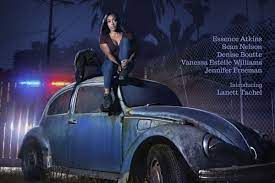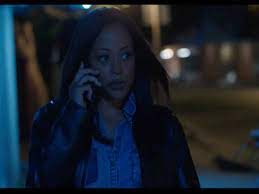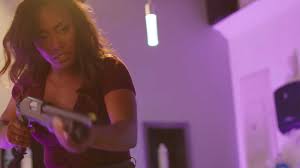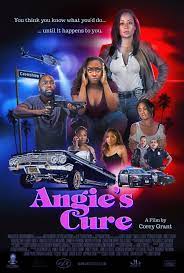By Valerie Milano
Los Angeles, CA (The Hollywood Times) 7/25/23 – In today’s world, it is certainly challenging for filmmakers to tell stories that are both highly entertaining and enlightening while dealing with difficult subjects, such as the realities of life shrouded in violence that faces most Black youth.
See our live interview. Click below:
But the writers of Angie’s Cure – which tells the harrowing tale of a rape victim’s disturbing road to recovery – have accomplished that feat, and brilliantly. The winner of the 2023 Grand Jury Award for Best Feature film at the recent Dances With Films Festival in Hollywood, Angie’s Cure tells the gripping story of a former rape victim who uses the thug robbing her shop to take out her repressed anger from a life fraught with blame for everyone else’s troubles, as well as her own self-loathing.
 The title character, played in adulthood by co-writer and co-producer Lanett Tachel, is raped at the age of 16 while attending a house party in a neighborhood of L.A.’s South Central area that also is the scene of a gang-related murder. That sets the stage for a 10-year odyssey of blame and recrimination for this young woman as she struggles to overcome her demons.
The title character, played in adulthood by co-writer and co-producer Lanett Tachel, is raped at the age of 16 while attending a house party in a neighborhood of L.A.’s South Central area that also is the scene of a gang-related murder. That sets the stage for a 10-year odyssey of blame and recrimination for this young woman as she struggles to overcome her demons.
Director/co-writer Corey Grant says the story is all too typical of life for Black youth growing up in violence in America, while also presenting them with hope for a changing future.
“I grew up in an area that had a lot of gang violence, and I lost friends to it,” Grant said in an exclusive interview with the Hollywood Times recently. “And you become desensitized to it…it is definitely a reality, not to everyone but to a lot of people.”
Tachel said it is a kind of duality between the violence that seems to be repeated generationally and the successful escape for that life which drives the characters in the film.
 “People say ‘you have to make it out,’ “she said. “And making it out just means that if you are in a place that perpetuates that violence, you either find a way to get the resources to figure out what you can do to leave and come back, and change that environment, or just leave so that they don’t become a victim.”
“People say ‘you have to make it out,’ “she said. “And making it out just means that if you are in a place that perpetuates that violence, you either find a way to get the resources to figure out what you can do to leave and come back, and change that environment, or just leave so that they don’t become a victim.”
Along with co-writer Brian P. Kelsey, Tachel and Grant use that violent beginning to weave a tale of revenge and redemption that, in the end, has the audience cheering for the most unlikely of heroes – the robber who becomes the object of Angie’s repressed anger over her lot in life as the whipping girl for everyone around her.
Grant said the phenomenon of “trauma bonding” certainly is central to Angie’s story and her eventual link to the burglar JD (Sean Nelson), but beyond that central theme, there is much more to the story.
 “The movie is about Angie and what she is dealing with, what she goes through, but it’s really not about Angie,” he said. “It’s about JD, it’s about police officers, it’s about several different people. And one of the things I wanted to get through (to audiences) is that you never really know what someone’s going through, what makes them do what they do.”
“The movie is about Angie and what she is dealing with, what she goes through, but it’s really not about Angie,” he said. “It’s about JD, it’s about police officers, it’s about several different people. And one of the things I wanted to get through (to audiences) is that you never really know what someone’s going through, what makes them do what they do.”
Speaking specifically about the story’s “bad guy,” Grant said you see the criminal that JD has become, but you don’t see the person that is that young man.
“You don’t know what caused him to go that route, Grant said. “You see the exterior. But when you peel back those layers, you see the human being…there is that duality to a lot of people. A lot of times we look at the exterior and form our opinions about people, but when we peel back those layer4s, we see why people are where they are, how did they get there, and who are they truly to their core.”
 Tachel said the film truly is about many different characters and how their lives intertwine, though they may not mesh in life in those moments. She said the various players in the film represent people the writers – and by extension, the audience – know in real life, and with whom that could identify.
Tachel said the film truly is about many different characters and how their lives intertwine, though they may not mesh in life in those moments. She said the various players in the film represent people the writers – and by extension, the audience – know in real life, and with whom that could identify.
“By putting these people together, we were showing what happens when all of these things collide,” she said. “And you realize there’s more that brings us together than what actually separates you as people. So that was really important that we show people that we know and people you could identify with in the story, so you don’t stay a victim, that at some point you realize that you have to reclaim your power.
”It’s one thing to start out as a victim,” she said, “but it’s how you choose to finish.”
In the end, Angie’s Cure is about just that – reclaiming the power to shape your future and not be a victim. As Angie herself says, it’s about “not letting one day define you.” That and sparking the conversations to foment change, are the real cure.
“There are so many times these things are common, generation after generation, and nobody talks about it,” Tachel said, calling it a “code of silence” that perpetuates this kind of downward spiral because people often down have a safe space to have those discussions.
 “More than anything, we wanted to encourage no matter what the viewers thought about it, to talk about it,” Tachel said. “Just to start a conversation.”
“More than anything, we wanted to encourage no matter what the viewers thought about it, to talk about it,” Tachel said. “Just to start a conversation.”
Grant agreed, saying the commonality of these kinds of experiences sets the stage for a larger learning environment that can lead to a better future.
“You have to realize, at any given point, you can find some help, find some resolution, learn from it and find a way to continue to move forward,” he said.




